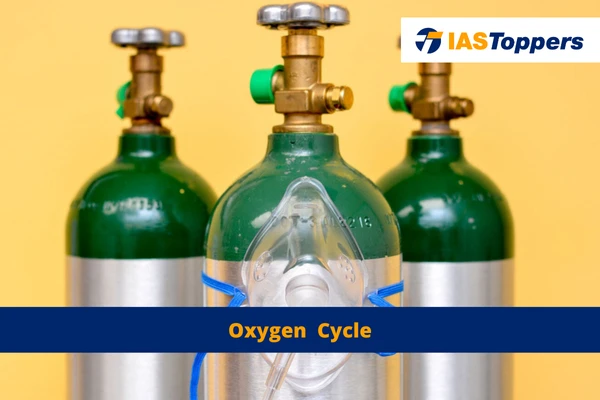Oxygen Cycle is a biogeochemical cycle that describes the movement of oxygen through the Earth’s atmosphere, hydrosphere, biosphere, and lithosphere. In this article, you will learn about oxygen cycle with diagram, oxygen cycle explanation, etc.
This article will provide key insights for GS Paper-III Environment and Ecology section of UPSC IAS Exam.
Table of Content
- Nutrient Cycle
- Facts about Oxygen
- What is Oxygen Cycle?
- Describe Oxygen Cycle in nature
- Oxygen cycle flow chart
- Oxygen cycle diagram
- Dissolved oxygen cycle
- Conclusion
- Frequently Asked Questions
Nutrient Cycle:
- Nutrients are never lost from the ecosystems but they are recycled again and again.
- The movement of nutrients from various components of an ecosystem is known as nutrient cycling.
- Nutrient cycling is also known as biogeochemical cycles.
- Nutrient cycles are of two types- gaseous and sedimentary.
Facts about Oxygen:
- Oxygen gas was first produced by cyanobacteria through the photosynthesis process.
- Oxygen is the second most abundant gas present in the atmosphere.
- Oxygen is an essential element for all organism as it helps in formation of biomolecules like proteins and nucleic acids.
- Phytoplankton produces most of the oxygen present in atmosphere followed by terrestrial plants and trees.
- Oxygen from the atmosphere is used up in 3 processes- combustion, respiration and in the formation of oxides of nitrogen.
What is Oxygen Cycle?
- The oxygen cycle is a biogeochemical cycle that describes the movement of oxygen through the Earth’s atmosphere, hydrosphere, biosphere, and lithosphere.
Describe Oxygen Cycle in nature:
- The process of oxygen cycle begins when plants or phytoplankton takes up carbon dioxide from the atmosphere and release oxygen back into the atmosphere as a by-product during the process of photosynthesis.
- Marine oxygen cycle: the oxygen released by phytoplankton becomes dissolved oxygen which is then taken up by aquatic animals.
- Equation of photosynthesis: 6CO2 + 6H2O → C6H12O6 + 6O2
- All aerobic organisms use oxygen for respiration, which is then used to breakdown the glucose present in the body and produce energy.
- This process releases carbon dioxide back into the atmosphere.Equation of respiration: C6H12O6 + 6O2→ 6CO2 + 6H2O
- This carbon dioxide is again utilised by the plants during photosynthesis.
- Some Oxygen is also utilised during the process of Combustion; Rusting and Decomposition.
- Some Oxygen is also produced when the sunlight reacts with water vapour or Ozone layer in the atmosphere.
- Some Oxygen is also present in lithosphere in the form of Oxides, which is in combination with the other elements.
- This Oxygen cannot be utilised by organism for respiration purpose.
Oxygen cycle flow chart:
Oxygen cycle diagram:
Dissolved oxygen cycle:
Conclusion
The importance of Oxygen Cycle in nature lies in the fact that it ensures constant support to organisms that requires Oxygen for breathing and all their biological process. Also, Oxygen being vital for all aerobic organism requires proper management and humans should minimize all such activities that hinder its proper production. The Oxygen and Carbon Dioxide cycle are often interlinked with each other where production of one lead to deduction of another element and vice versa.
Ref: Source-1
| Other Articles in Environment & Disaster Management | |
| Phosphorus Cycle | Central Pollution Control Board (CPCB) |
| Energy Flow in Ecosystem | Carbon FootPrint |
| Black Carbon | Ecological Pyramid |
FAQs (frequently asked question)
Define oxygen cycle.
The oxygen cycle is a biogeochemical cycle that describes the movement of oxygen through the Earth’s atmosphere, hydrosphere, biosphere, and lithosphere.
What is Mineralization?
Mineralization is the process by which bacteria break down organic matter and release inorganic phosphorus.
How does the Oxygen Cycle work?
The Oxygen Cycle takes place due to the continuous process of photosynthesis, respiration, combustion, rusting, oxide formation etc.
How are the carbon nitrogen and oxygen cycles similar?
The carbon, oxygen, and nitrogen cycles are all biogeochemical cycles that utilises atmosphere in its process.
How does cutting down of trees affect the oxygen cycle?
The removal of trees results in higher carbon dioxide in the atmosphere and reduced oxygen which then impeded the process of oxygen cycle.
What are the advantages and disadvantages of oxygen cycle?
Oxygen cycle reacts with nonmetals like nitrogen, carbon and sulphur to form toxic compounds which are harmful when inhaled by organisms. Oxygen cycle also leads to rusting of Iron, contributing to economic loss. The advantages of Oxygen cycle are that it ensures constant support to organisms that requires Oxygen for breathing and all their biological process.





